
Ahead of the crucial Gujarat elections, the chinks in the propaganda armour of Indian Prime Minister Narendra Modi’s Gujarat model of development continue to get brutally exposed. Indeed, the popular narrative on development that has emerged from within Gujarat – where Modi was chief minister prior to becoming PM – and that has taken social media by storm is that “vikas gando thayo chhe” – “development has gone crazy”.
This is not just about Gujarat, this can be said about the dominant discourse and model of development in the rest of India. And it is not a recent phenomenon, occurring only in the wake of Modi’s 2014 victory when the “Gujarat model” was sought to be replicated nationally.
Crazy development is a characteristic outcome of crony capitalism, when the resources and focus of the state are increasingly dedicated to the interests of a handful of corporations and well-connected cronies.
As economic observers, including former finance ministers from within the ruling Bharatiya Janata Party (BJP), express concern over the six quarters of consecutive decline in the GDP growth rate, and reports of job losses in virtually every industry and employment sector continue coming in, the latest International Food Policy Research Institute report on the state of global hunger tells us that India is ranked 100 in a list of 117 countries.
What is even more worrying is that after a marginal improvement from 2011 to 2015 when India’s ranking went up from 108 among 122 countries in 2011 to 93 among 117 countries in 2015, India’s ranking has slipped over the past two years, down to 97 among 118 countries in 2016 and 100 in 2017. India’s 2017 Global Hunger Index (GHI) of 31.4 places it at the “higher end of the serious category”.
The report exposes the disturbing state of affairs behind the government’s lofty rhetoric and tall claims of “Digital India” and “Make in India”. However shocking and shameful, the report is hardly surprising for those who are aware of the reality in India.
The phenomenon of child deaths in government hospitals is a bitter reality in several states. From Simdega in Jharkhand has come the stunning news of a young girl dying of starvation after being denied food for not having an Aadhaar ID ration card.
Chronic deprivation – lack of access to food, drinking water, sanitation and housing – combined with cruel exclusion in the name of non-possession of an Aadhaar ID card has rendered sizable sections of our population permanently vulnerable to acute malnutrition and hunger.
The GHI is not, however, the only global index that reveals India’s disturbing comparative position. The world slavery report, put out by the International Labour Organisation in collaboration with the Walk Free Foundation, puts India in first place with 1.4% of the population, or more than 18 million people, estimated to be trapped in various forms of slavery.
Add to this acute malnutrition and hunger the growing burden of unemployment and under-employment, the soaring prices of essential goods and services and the lack of state expenditure and investment in public welfare, and we get an alarming picture of the living conditions facing the common people.
Governments have been trying hard to keep this grim reality hidden behind the misleading statistics of GDP growth, but now even GDP figures no longer paint a rosy picture. The growing concentration of wealth in the hands of an ever smaller minority leaves the rest of society reeling precariously under the burden of economic inequality.
Renowned economists Thomas Piketty and Lucas Chancel of the Paris School of Economics have detected an alarming rise in economic inequality in India. Between 1980 and 2014, the share in income of the top 1% of India’s population rose from 6% to 22%. During the same period, the share of the top 10% rose from 30% to 50%; the share of the middle 40% (the middle class) fell from 43% to 30%; and the share of the bottom 50% fell from 24% to 15%.
The Hindu nationalist Sangh-BJP establishment knows of only one way to tackle this growing economic disaster – by sharpening communal polarisation in the country. No wonder the BJP has even begun targeting the Taj Mahal as being “alien” and non-Indian, and projecting Yogi Adityanath, who has emerged as an epitome of communal vitriol and failed governance in Uttar Pradesh, as a star BJP campaigner from Kerala to Gujarat.
It is desperately trying to politicise the mutual clashes between the right-wing Hindu nationalist Rashtriya Swayamsevak Sangh (RSS) and Communist Party of India (Marxist) in Kerala’s Kannur district as a “Marx against Hindus” bogey and has spearheaded a violent anti-Communist campaign across the country.
But if the byelection results of Gurdaspur LS seat or Vengara assembly seat in Kerala, or for that matter the results of the Allahabad University Students’ Union elections, are anything to go by, the BJP is finding it increasingly difficult to hide its failure and betrayal in economic or administrative governance behind communal aggression and jingoistic rhetoric.
The rise of the disastrous Modi model began in Gujarat; let the sign of its downfall also emanate from the coming Gujarat elections.
[Dipankar Bhattacharya is the general secretary of the Communist Party of India (Marxist-Leninist) Liberation. Reprinted from Liberation.]
Like the article? Subscribe to Green Left now! You can also like us on Facebook and follow us on Twitter.